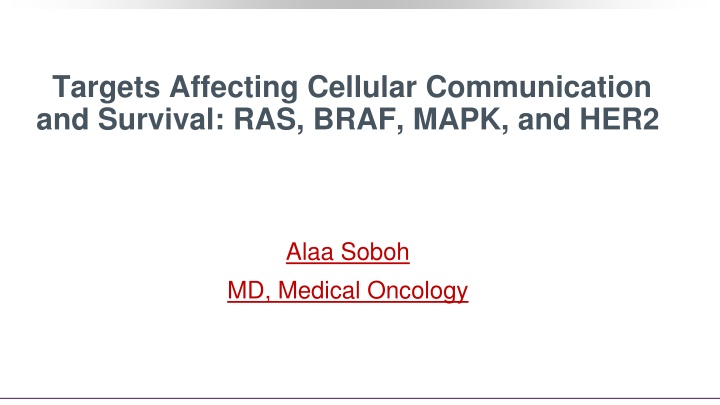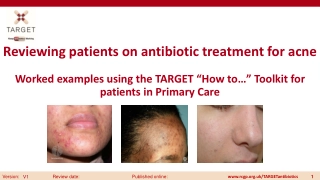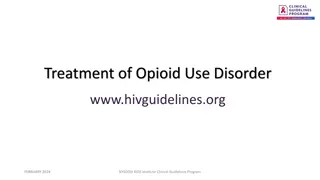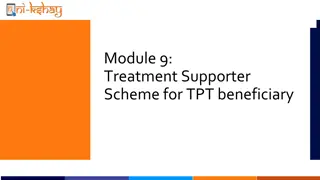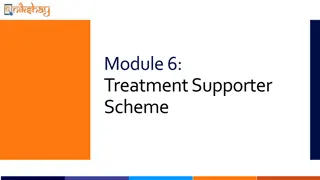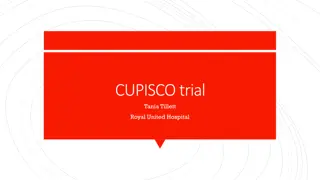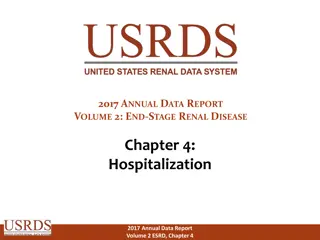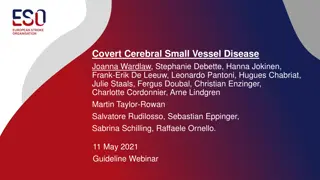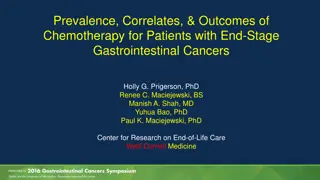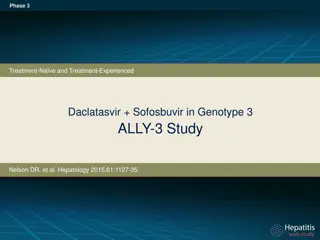Influencing Treatment Choices in mCRC Patients
Patient and molecular characteristics, prior treatment history, comorbidities, and tumor characteristics all play a significant role in determining treatment strategies for patients with metastatic colorectal cancer (mCRC). This content discusses the factors that influence treatment decisions in mCRC and highlights the importance of tailoring therapy based on individual patient needs.
Download Presentation

Please find below an Image/Link to download the presentation.
The content on the website is provided AS IS for your information and personal use only. It may not be sold, licensed, or shared on other websites without obtaining consent from the author.If you encounter any issues during the download, it is possible that the publisher has removed the file from their server.
You are allowed to download the files provided on this website for personal or commercial use, subject to the condition that they are used lawfully. All files are the property of their respective owners.
The content on the website is provided AS IS for your information and personal use only. It may not be sold, licensed, or shared on other websites without obtaining consent from the author.
E N D
Presentation Transcript
Targets Affecting Cellular Communication and Survival: RAS, BRAF, MAPK, and HER2 Alaa Soboh MD, Medical Oncology
Patient Case A 64-yr-old female patient is diagnosed with stage IV descending colon cancer with synchronous unresectable liver, lung, peritoneal, and retroperitoneal metastases She has a good performance status but has back and RUQ pain for which she receives opioids She has no signs of bowel obstruction
What Influences Treatment Choices in mCRC? Patient characteristics Molecular characteristics Prior adjuvant treatment BRAF Comorbidities RAS 1L Performance status Age HER2 MSI-high 2L Patient preference Tumor 3L characteristics Quality of life Toxicity profile Resectability Tumor burden 4L Tumor location Therapy tailored according to individual patient needs Slide credit: clinicaloptions.com
Case 1: Results of Biomarker Testing Standard IHC screening for MMR protein expression reveals absence of MLH-1 Subsequent MSI-testing qualifies the cancer as MSI-H Further workup identifies a BRAF V600E mutation in the cancer tissue No RAS mutation or HER2 amplification is found Slide credit: clinicaloptions.com
The Perfect Candidate for Treatment With First-line EGFR Antibodies Negative selection (mutually exclusive) KRAS/NRAS/HRAS exon 2, 3, 4 wild type - 55% No BRAF V600E mutation - 8% (No HER2 amplification -2.5%) Further exclusion criteria (not mutually exclusive) Right-sided cancers 30% Slide credit: clinicaloptions.com
FDA-Approved Indications for BRAF Inhibitors Dabrafenib Trametinib Encorafenib + binimetinib Unresectable or metastatic melanoma with BRAF V600E or BRAF V600K[5,6] Unresectable or metastatic melanoma with BRAF V600E[1] Unresectable or metastatic melanoma with BRAF V600E or BRAF V600K[2] Dabrafenib + trametinib Vemurafenib Unresectable or metastatic melanoma with BRAF V600E[3] Adjuvant treatment for melanoma with BRAF V600E or BRAF V600K and LN involvement after complete resection[1,2] Erdheim-Chester disease with BRAF V600E [3] Unresectable or metastatic melanoma with BRAF V600E or BRAF V600K[1,2] Vemurafenib + cobimetinib Metastatic NSCLC with BRAF V600E[1,2] Unresectable or metastatic melanoma with BRAF V600E or BRAF V600K[3,4] LA or metastatic anaplastic thyroid cancer with BRAF V600E and no locoregional treatment options[1,2] Slide credit: clinicaloptions.com 1. Dabrafenib PI. 2. Trametinib PI. 3. Vemurafenib PI. 4. Cobimetinib PI. 5. Encorafenib PI. 6. Binimetinib PI.
PETACC-3 Adjuvant 5-FU/LV Irinotecan in CRC: OS After Relapse According to BRAF Mutation Status 100 80 Median OS, Mos Mutated BRAF: 7.49 Wild-type BRAF: 25.2 P = 1.9e-11 BRAF 60 mut OS, % 40 BRAF wildtype 20 Slide credit: clinicaloptions.com Tejpar. ASCO 2010. Abstr 3505. Roth. JCO. 2010;28:466.
S1406: PFS With Cetuximab + Irinotecan Vemurafenib 100 Events, nmPFS (95% CI) 40 4.3 (3.6-5.7) 48 2.0 (1.8-2.1) Vemurafenib + cetuximab + irinotecan 80 Cetuximab + irinotecan HR: 0.48 (95% CI: 0.31-0.75; P = .001) 60 PFS (%) Median follow-up: 7.3 mos 40 48% of patients crossed over to VIC after PD on IC; median PFS: 5.8 mos 20 0 0 6 10 14 3 8 12 Mos Slide credit: clinicaloptions.com Kopetz. ASCO 2017. Abstr 3505.
S1406: ORR, OS With Cetuximab + Irino Vemurafenib Cetuximab + Irinotecan 100% 4% OS (mos) 20% 0% N Median 95% CI 50 5.9 (3.0-9.9) 49 9.6 (7.5-13.1) Cetuximab + irinotecan Vemurafenib + cetuximab + irinotecan -30% DCR 22% -100% Vemurafenib + Cetuximab + Irinotecan 100% HR: 0.73 (95% CI: 0.45-1.17; P = .19) 16% 20% 0% -30% DCR 67% -100% Slide credit: clinicaloptions.com Kopetz. ASCO 2017. Abstr 3505.
BEACON CRC: Encorafenib/Cetuximab Binimetinib vs Cetuximab/Chemotherapy in BRAF+Metastatic CRC Randomized, open-label phase III trial Binimetinib 45 mg BID Encorafenib 300 mg QD Cetuximab 400 mg/m2 250 mg/m2 QW (n = 205) Safety Lead-in Patients with BRAF V600E+ mCRC with PD on 1-2 regimens (no prior RAF/MEK/EGFRi); no symptomatic brain mets (N = 30 in safety lead-in; planned N = 645) Patients followed for OS beyond progression Binimetinib 45 mg BID Encorafenib 300 mg QD Cetuximab 400 mg/m2 250 mg/m2 QW Encorafenib 300 mg QD Cetuximab 400 mg/m2 250 mg/m2 QW (n = 205) Investigator s Choice FOLFIRI/Cetuximab or Irinotecan/Cetuximab (n = 205) N = 30 Slide credit: clinicaloptions.com Van Cutsem. JCO. 2019;[Epub]. NCT02928224
Encorafenib, Cetuximab, + Binimetinib in BRAF+mCRC: Tumor Change in BEACON CRC SLI Phase[1] Cetuximab + Irinotecan from SWOG S1406[2] 100 Best Change From Baseline (%) CR (n = 3) PR (n = 11) Other (n = 14) 80 60 40 20 0 -20 -40 -60 ORR: 48% Median PFS: 8.0 mos -80 -100 Patients Slide credit: clinicaloptions.com 1. Van Cutsem. JCO. 2019;[Epub]. 2. Kopetz. ASCO 2017. Abstr 3505.
Encorafenib, Cetuximab, + Binimetinib in BRAF+ Metastatic CRC: OS in BEACON CRC SLI Phase Safety Lead-in (# events/n=17/29) Median=15.3 months, 95% CI: 9.6, NR Safety Lead-in (events/N = 17/29) Median OS: 15.3 months (95% CI: 9.6-NR) Censored Patients 1 Prior Regimen 88 63 2 Prior Regimens 85 62 OS, % 6 mos 12 mos Current guidelines: Category 2A recommendation since 3/19 Slide credit: clinicaloptions.com Van Cutsem. JCO. 2019;[Epub].
Encorafenib, Cetuximab, + Binimetinib in BRAF+ Metastatic CRC: AEs in BEACON CRC SLI Phase Adverse Event in 20% of Pts with Any Grade or 10% of Pts with Grade 3/4, n (%) Diarrhea Dermatitis acneiform Fatigue Nausea Vomiting Dry skin Anemia Decreased appetite Abdominal pain Increased creatinine kinase Pyrexia Dyspnea Constipation Arthralgia Creatine increased Skin fissure Vision blurred Increased aspartate aminotransferase Asthenia Malaise Myalgia PPED syndrome Rash maculopapular Urinary tract infection Any Grade 23 (77) 20 (67) 19 (63) 19 (63) 15 (50) 15 (50) 12 (40) 12 (40) 11 (37) 11 (37) 11 (37) 10 (33) 9 (30) 8 (27) 8 (27) 8 (27) 8 (27) 6 (20) 6 (20) 6 (20) 6 (20) 6 (20) 6 (20) 5 (17) Grade 3/4 -- -- 4 (13) 2 (7) 2 (7) -- 3 (10) 2 (7) -- 3 (10) -- 2 (7) -- -- -- -- -- 3 (10) -- -- -- -- -- 3 (10) Slide credit: clinicaloptions.com Van Cutsem. JCO. 2019;[Epub].
BEACON Press Release May 21, 2019 ORR, % OS, Mos Triplet ORR N 331 665 Second line: 34.3% Third line: 22.4% Triplet 26.1 9.0 HR: 0.52 P < .0001 P < .0001 HR: 0.79 P = .116* Control 1.9 5.4 HR: 0.60 P = .0003 P < .0001 Doublet 20.4 8.4 *Nominal P value. Blinded independent central review of the first 331 randomized patients.
Database Analysis: Prevalence of Non-V600 BRAF Mutations in Metastatic CRC Non-V600 BRAF Mutations, % (n/N) Database, n All BRAF Mutations, % (n/N) Population Characteristic Total, n MD Foundation Medicine Of All BRAFmut Of All CRC Cases Mayo Clinic Anderson Total CRC cases 1014 2276 6353 9643 Total BRAF mutations 10.0 162 334 469 965 (9643/965) Non-V600 BRAF mutations 21.5 2.2 29 53 126 208 (208/965) (208/9643) Outcomes data available for 101 patients with non-V600 BRAF mutations Slide credit: clinicaloptions.com Jones. JCO. 2017;35:2624.
Database Analysis: Distribution of Non-V600 BRAF Mutations in Metastatic CRC Slide credit: clinicaloptions.com Jones. JCO. 2017;35:2624.
Overall Survival by BRAF Status Database Analysis: OS by BRAF Mutation in mCRC 1.00 Overall Survival by BRAF Status 100 1.00 Median OS, Mos BRAF V600E: BRAF non-V600E: BRAF wild type: 11.4 60.7 43.0 0.75 0.75 75 P < .001 Survival (%) nonV600 nonV600 Non-V600 V600E WT Survival 0.50 0.50 50 Survival V600E WT V600E WT 0.25 25 0.25 0.00 0 0 0 50 50 100 100 150 150 Months from Diagnosis Mos Slide credit: clinicaloptions.com Jones. JCO. 2017;35:2624. 0.00 0 50 100 150 Months from Diagnosis
BRAF Inhibitors in Metastatic CRC Dabrafenib + trametinib + cetuximab or panitumumab Vemurafenib + irinotecan + cetuximab or panitumumab Encorafenib + binimetinib + cetuximab or panitumumab Guideline recommended for metastatic CRC with BRAF V600E after oxaliplatin- or irinotecan-based treatment (not FDA indicated) Guideline recommended for metastatic CRC with BRAF V600E after oxaliplatin- or irinotecan-based treatment (not FDA indicated) Guideline recommended for metastatic CRC with BRAF V600E after oxaliplatin- or irinotecan-based treatment (not FDA indicated) BEACON phase III trial recently met primary endpoint of ORR and OS in interim analysis Slide credit: clinicaloptions.com
HER2Amplification in Patients With Colorectal Cancer HER2 overexpression and amplification is seen in a distinct subset of mCRC IHC 2+ (Borderline) IHC 3+ (Positive) Study N Positive Rate IHC/FISH Concordance IHC: 5(3.6%) FISH: 4(2.4%) IHC: 8(3%) FISH: 8(3%) IHC: 39(3%) FISH: 36(3%) Nathanson[1] 139 2 3 K =0.85 Ooi[2] 244 2 6 100% Marx[3] 1439 1822 12 16 27 36 100% Good Summary Unselected (n = 2349) (patients) KRAS wild type (n = 44) (patients) Quadruple negative (n = 11) (xenopatients) ERBB2 4% KRAS 41% 2.7% (2.5-3.7%) 13.6% (P < .01%) 36.4% (P < .001) BRAF 10% NRAS 9% PIK3CA 20% Amplification Mutation HER2 amplification 5.3% HER2 amplification seen in HERACLES Study (screened = 836)[4] HER2 amplification enriched in KRAS, NRAS, BRAF, and PIK3CA WT tumors[5,6] 1. Nathanson. Int J Cancer. 2003; 105:796. 2. Ooi. Mod Pathol. 2004;17:895 3. Marx. Human Path. 2010;41:1577. 4. Siena. ASCO 2015. Abstr TPS774. 5. Bertotti. 2011;1:508. 6. Kuwada. 2004;109:291. Slide credit: clinicaloptions.com
HER2 Amplification in Colorectal Cancer Resistance marker for EGFR antibodies Defines patients who are candidates for HER2-targeted therapy Slide credit: clinicaloptions.com
HERACLES: Trastuzumab + Lapatinib for Patients With Treatment Refractory KRAS WT/HER2+ mCRC Multicenter, open-label phase II study Patients with HER2+, KRAS exon 2 WT metastatic CRC not amenable to surgery; PD on prior treatment with fluoropyrimidines, irinotecan, oxaliplatin, cetuximab, or panitumumab*; ECOG PS 0/1; no CNS metastases (N = 27) Trastuzumab* 2 mg QW + Lapatinib 1000 mg QD (n = 1420) *Loading dose 4 mg/kg IV Progressive disease (Enrolled n=24; evaluable n=23) Primary endpoint: ORR (RECIST 1.1 by BICR) Secondary endpoints: TTP, safety Translational: HER2 ctDNA in plasma, HER2 ectodomain in serum, NGS in tissue and plasma in de novo resistant patients and upon PD *Bevacizumab, aflibercept or regorafenib allowed but not mandatory Slide credit: clinicaloptions.com Sartore-Bianchi. Lancet Oncol. 2016;17:738.
Trastuzumab + Lapatinib in KRAS WT/HER2+ mCRC (HERACLES): Response Primary endpoint met in advance with 8/27 objective responses (as per protocol, 6/27 needed to declare the study positive) Best Response (RECIST 1:1 BICR) Number % Responses (PR + CR) 8 30 59% DCR CR 1 4 PR 7 26 Stable disease 4 mos 8 30 Stable disease < 4 mos 4 15 Progressive disease 7 25 Total 27 100 Slide credit: clinicaloptions.com Sartore-Bianchi. Lancet Oncol. 2016;17:738.
